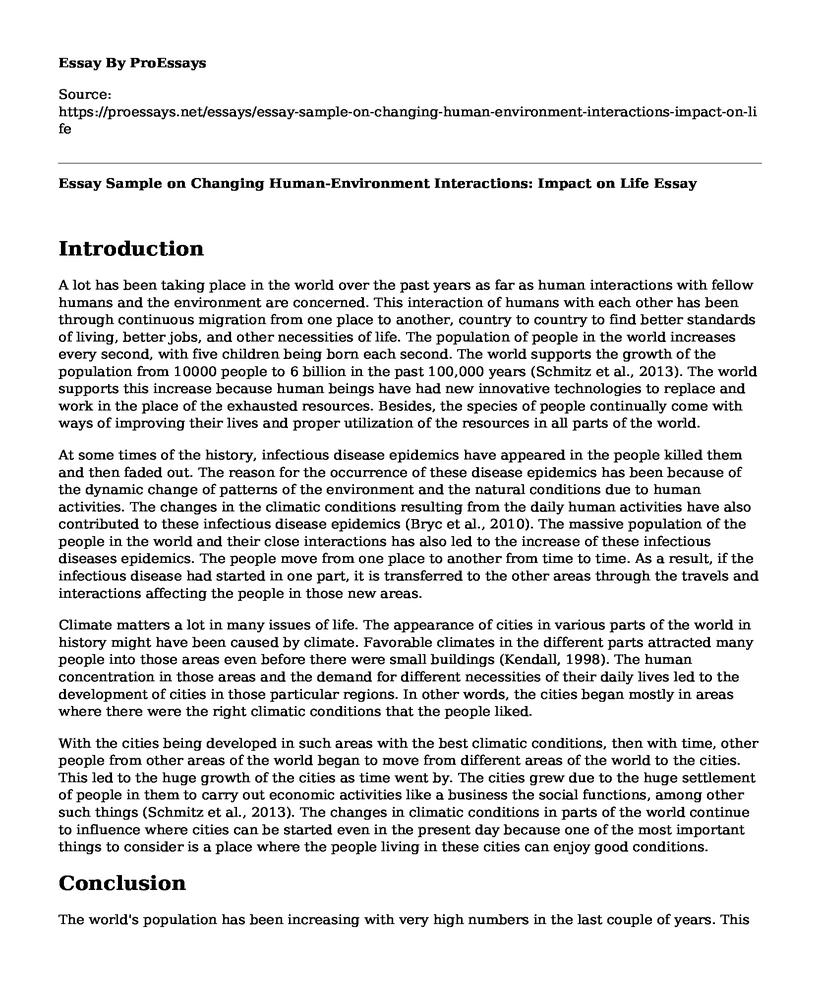Introduction
A lot has been taking place in the world over the past years as far as human interactions with fellow humans and the environment are concerned. This interaction of humans with each other has been through continuous migration from one place to another, country to country to find better standards of living, better jobs, and other necessities of life. The population of people in the world increases every second, with five children being born each second. The world supports the growth of the population from 10000 people to 6 billion in the past 100,000 years (Schmitz et al., 2013). The world supports this increase because human beings have had new innovative technologies to replace and work in the place of the exhausted resources. Besides, the species of people continually come with ways of improving their lives and proper utilization of the resources in all parts of the world.
At some times of the history, infectious disease epidemics have appeared in the people killed them and then faded out. The reason for the occurrence of these disease epidemics has been because of the dynamic change of patterns of the environment and the natural conditions due to human activities. The changes in the climatic conditions resulting from the daily human activities have also contributed to these infectious disease epidemics (Bryc et al., 2010). The massive population of the people in the world and their close interactions has also led to the increase of these infectious diseases epidemics. The people move from one place to another from time to time. As a result, if the infectious disease had started in one part, it is transferred to the other areas through the travels and interactions affecting the people in those new areas.
Climate matters a lot in many issues of life. The appearance of cities in various parts of the world in history might have been caused by climate. Favorable climates in the different parts attracted many people into those areas even before there were small buildings (Kendall, 1998). The human concentration in those areas and the demand for different necessities of their daily lives led to the development of cities in those particular regions. In other words, the cities began mostly in areas where there were the right climatic conditions that the people liked.
With the cities being developed in such areas with the best climatic conditions, then with time, other people from other areas of the world began to move from different areas of the world to the cities. This led to the huge growth of the cities as time went by. The cities grew due to the huge settlement of people in them to carry out economic activities like a business the social functions, among other such things (Schmitz et al., 2013). The changes in climatic conditions in parts of the world continue to influence where cities can be started even in the present day because one of the most important things to consider is a place where the people living in these cities can enjoy good conditions.
Conclusion
The world's population has been increasing with very high numbers in the last couple of years. This has been aided by the interactions of humans with each other in the world. Statistics show that in another 100,000 years to come, the population of the world will be almost growing to double the current number today. The demographic changes will lead to a serious impact on the lives of the people in areas of health, settlements, and several other areas.
References
Bryc, K., Velez, C., Karafet, T., Moreno-Estrada, A., Reynolds, A., Auton, A., ... & Ostrer, H. (2010). Genome-wide patterns of population structure and admixture among Hispanic/Latino populations. Proceedings of the National Academy of Sciences, 107(Supplement 2), 8954-8961.
Kendall, B. E., Prendergast, J., & Bjornstad, O. N. (1998). The macroecology of population dynamics: taxonomic and biogeographic patterns in population cycles. Ecology Letters, 1(3), 160-164.
Schmitz, R. J., Schultz, M. D., Urich, M. A., Nery, J. R., Pelizzola, M., Libiger, O., ... & Ecker, J. R. (2013). Patterns of population epigenomic diversity. Nature, 495(7440), 193-198.
Cite this page
Essay Sample on Changing Human-Environment Interactions: Impact on Life. (2023, Apr 28). Retrieved from https://proessays.net/essays/essay-sample-on-changing-human-environment-interactions-impact-on-life
If you are the original author of this essay and no longer wish to have it published on the ProEssays website, please click below to request its removal:
- The Process of Blood Flow and Sporting Events
- Why Orca Whales Should Not Live in Captivity Essay
- Course Work Sample: Body Joints, Human Skeleton and Skeletal Muscle
- Compare and Contrast Essay on ALF and PETA
- Animal Zoos Argumentative Essay Example
- Preserving Human Dignity: Human Reproductive Cloning
- Animal Testing: Pros & Cons of a Controversial Practice - Essay Sample







